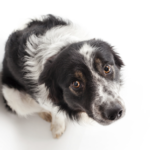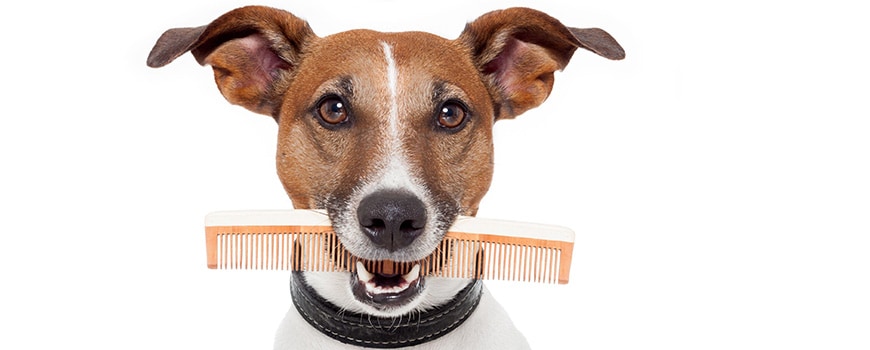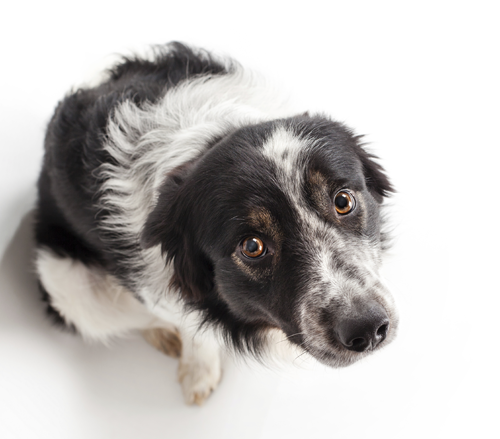Knowing dog body language will help you know how to react to it. Knowing what to do will help your dog overcome his fears and keep you safe. And this will come quite handy when grooming your dog at home, or even than when you let a professional to do the grooming.
Calm Mood
A calm, relaxed dog is generally the easiest dog to work on. If you are calm and relaxed, the dog will be, too. Calm, relaxed body language is:
- Ears relaxed, up, neutral
- Mouth partially open, no teeth showing
- Tail is low/neutral
- Standing up, dog is bearing weight equally on all four legs
Playful Mood
A dog in a playful mood should have a few rounds of fun before you begin grooming her. You can tell if a dog is in a playful mood from her body language:
- Ears up and forward
- Play bow—hind end up and front end down
- Tail up
- Rapid, jerky movements, hopping, moving from side to side
- Barking at you to play with her
Submissive Dogs
This dog is telling you, “I’m no threat, don’t hurt me.” To make this dog feel more comfortable, pat his tummy, speak softly in a happy and upbeat tone, and give him some confidence. Submissive dogs exhibit the following body language:
- Ears back and down
- Body lowered
- Tail down, may wag a bit
- Mouth may be partially open with tongue protruding
- May whine
- May roll on his back
Fearful Dogs
This dog is scared and can be very dangerous if you approach her too quickly; she may bite out of fear. If she can’t run away from you, she will snap at you to protect herself. You must know the signs of a fearful dog. Fortunately, they are easy to recognize:
- Ears back
- Body leaning back, weight centered on hind legs
- Tail down and curled between legs
- Mouth closed
- Hair may stand on end
Import ant! Fearful dogs require a slow approach. Don’t stare the dog directly in the eye, which is a threatening gesture to a dog. Crouch down and get on his level without looking directly at him. This makes you less intimidating. Be confident and don’t make quick movements.
ant! Fearful dogs require a slow approach. Don’t stare the dog directly in the eye, which is a threatening gesture to a dog. Crouch down and get on his level without looking directly at him. This makes you less intimidating. Be confident and don’t make quick movements.
This dog requires special handling. This is not a dog you will be able to groom in one sitting. He needs desensitization to whatever is scaring him. This is where you start out with the least threatening thing to the dog—your hand stroking his back.
Advance to something else, maybe a cotton ball or paper towel. Slowly graduate to scarier situations until he understands that nothing will hurt him. This process takes time. You can try tempting this dog with treats, but most fearful dogs won’t take treats from you. If he does take a treat, he may take it and run away.
Tethering the fearful dog to you so she can’t go too far away from you helps because she learns to get comfortable a few feet away from you. She also learns to follow you when you walk around the house. Once the dog is comfortable being around you, only then should you progress to the next level.
If your dog begins acting fearful, you are moving too fast. Back up and go back to where the dog is comfortable. Always speak in a soft, low tone to this dog, and move slowly.
Once you have established trust, this dog should come out of her shell and warm up to the idea of you grooming her. If you are not making progress, you should consult a behaviorist to help you.
Threatening Dogs
Threatening dogs are not hard to spot:
- Ears up and forward
- Body up on toes and forward, weight centered on forelegs
- Tail up
- Hair may stand on end
- Mouth open
- May growl or show teeth
This dog is warning you. If this is your dog, he may be displaying this threatening behavior to keep you in line. It can be a form of dominance. After all, if he growls and you back off, it works. If you are not confident around this dog, he knows it and he will take advantage of this.
You need to be the leader of your pack to stop this behavior. Learning how to walk this dog properly helps immensely, as does gaining confidence in your ability to handle the dog.
Consult a dog trainer for help. Some animal behaviorists can also deal with the threatening dog, but it’s really the human who needs to learn how to behave in a calm, assertive way toward the dog. Never attempt to groom or handle the dog that is acting this way unless you are confident.
Fact! Many dogs show dominance when they are groomed. They may object to brushing, bathing, or drying, and may snap at the tools or your hands to prevent you from invading their space. This is why its important for owners to instill pack order in dogs, regardless of size. Each dog must understand that humans come first.
Offensive or Aggressive Dogs
Offensive or aggressive dogs can be extremely dangerous. Look for body language like:
- Ears up and forward
- Staring directly at target or looking from corner of eye
- Body leaning/moving forward
- Tail is up and stiff—may appear to be wagging, but it’s a warning!
- Lips puckered or mouth open with teeth exposed
Don’t touch this dog! The majority of dogs do not fall into this category but they do exist. This is not a dog for a novice to work with. Get an experienced trainer to help you. If your dog is acting this way, heed the warnings and get in touch with a dog trainer or animal behaviorist to help you deal with the problem.

